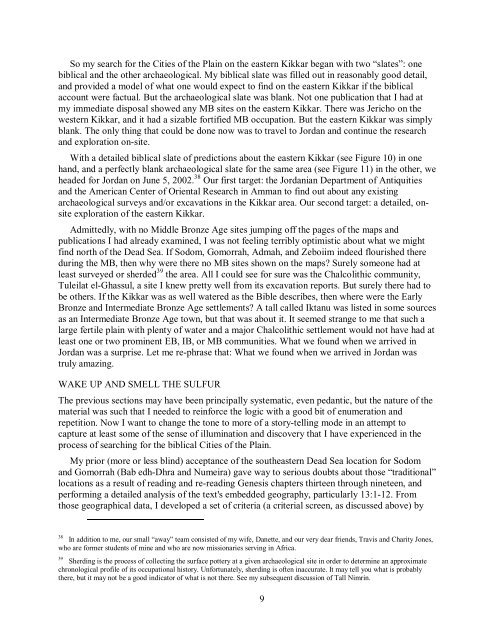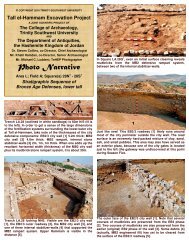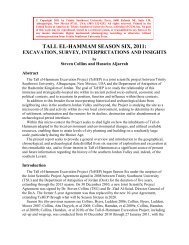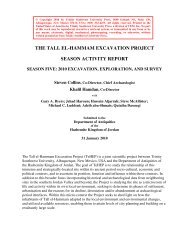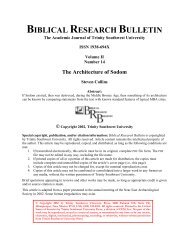Explorations on the - Tall el-Hammam Excavation Project, Jordan
Explorations on the - Tall el-Hammam Excavation Project, Jordan
Explorations on the - Tall el-Hammam Excavation Project, Jordan
You also want an ePaper? Increase the reach of your titles
YUMPU automatically turns print PDFs into web optimized ePapers that Google loves.
So my search for <strong>the</strong> Cities of <strong>the</strong> Plain <strong>on</strong> <strong>the</strong> eastern Kikkar began with two “slates”: <strong>on</strong>e<br />
biblical and <strong>the</strong> o<strong>the</strong>r archaeological. My biblical slate was filled out in reas<strong>on</strong>ably good detail,<br />
and provided a mod<strong>el</strong> of what <strong>on</strong>e would expect to find <strong>on</strong> <strong>the</strong> eastern Kikkar if <strong>the</strong> biblical<br />
account were factual. But <strong>the</strong> archaeological slate was blank. Not <strong>on</strong>e publicati<strong>on</strong> that I had at<br />
my immediate disposal showed any MB sites <strong>on</strong> <strong>the</strong> eastern Kikkar. There was Jericho <strong>on</strong> <strong>the</strong><br />
western Kikkar, and it had a sizable fortified MB occupati<strong>on</strong>. But <strong>the</strong> eastern Kikkar was simply<br />
blank. The <strong>on</strong>ly thing that could be d<strong>on</strong>e now was to trav<strong>el</strong> to <strong>Jordan</strong> and c<strong>on</strong>tinue <strong>the</strong> research<br />
and explorati<strong>on</strong> <strong>on</strong>-site.<br />
With a detailed biblical slate of predicti<strong>on</strong>s about <strong>the</strong> eastern Kikkar (see Figure 10) in <strong>on</strong>e<br />
hand, and a perfectly blank archaeological slate for <strong>the</strong> same area (see Figure 11) in <strong>the</strong> o<strong>the</strong>r, we<br />
headed for <strong>Jordan</strong> <strong>on</strong> June 5, 2002. 38 Our first target: <strong>the</strong> <strong>Jordan</strong>ian Department of Antiquities<br />
and <strong>the</strong> American Center of Oriental Research in Amman to find out about any existing<br />
archaeological surveys and/or excavati<strong>on</strong>s in <strong>the</strong> Kikkar area. Our sec<strong>on</strong>d target: a detailed, <strong>on</strong>site<br />
explorati<strong>on</strong> of <strong>the</strong> eastern Kikkar.<br />
Admittedly, with no Middle Br<strong>on</strong>ze Age sites jumping off <strong>the</strong> pages of <strong>the</strong> maps and<br />
publicati<strong>on</strong>s I had already examined, I was not fe<strong>el</strong>ing terribly optimistic about what we might<br />
find north of <strong>the</strong> Dead Sea. If Sodom, Gomorrah, Admah, and Zeboiim indeed flourished <strong>the</strong>re<br />
during <strong>the</strong> MB, <strong>the</strong>n why were <strong>the</strong>re no MB sites shown <strong>on</strong> <strong>the</strong> maps? Sur<strong>el</strong>y some<strong>on</strong>e had at<br />
least surveyed or sherded 39 <strong>the</strong> area. All I could see for sure was <strong>the</strong> Chalcolithic community,<br />
Tuleilat <strong>el</strong>-Ghassul, a site I knew pretty w<strong>el</strong>l from its excavati<strong>on</strong> reports. But sur<strong>el</strong>y <strong>the</strong>re had to<br />
be o<strong>the</strong>rs. If <strong>the</strong> Kikkar was as w<strong>el</strong>l watered as <strong>the</strong> Bible describes, <strong>the</strong>n where were <strong>the</strong> Early<br />
Br<strong>on</strong>ze and Intermediate Br<strong>on</strong>ze Age settlements? A tall called Iktanu was listed in some sources<br />
as an Intermediate Br<strong>on</strong>ze Age town, but that was about it. It seemed strange to me that such a<br />
large fertile plain with plenty of water and a major Chalcolithic settlement would not have had at<br />
least <strong>on</strong>e or two prominent EB, IB, or MB communities. What we found when we arrived in<br />
<strong>Jordan</strong> was a surprise. Let me re-phrase that: What we found when we arrived in <strong>Jordan</strong> was<br />
truly amazing.<br />
WAKE UP AND SMELL THE SULFUR<br />
The previous secti<strong>on</strong>s may have been principally systematic, even pedantic, but <strong>the</strong> nature of <strong>the</strong><br />
material was such that I needed to reinforce <strong>the</strong> logic with a good bit of enumerati<strong>on</strong> and<br />
repetiti<strong>on</strong>. Now I want to change <strong>the</strong> t<strong>on</strong>e to more of a story-t<strong>el</strong>ling mode in an attempt to<br />
capture at least some of <strong>the</strong> sense of illuminati<strong>on</strong> and discovery that I have experienced in <strong>the</strong><br />
process of searching for <strong>the</strong> biblical Cities of <strong>the</strong> Plain.<br />
My prior (more or less blind) acceptance of <strong>the</strong> sou<strong>the</strong>astern Dead Sea locati<strong>on</strong> for Sodom<br />
and Gomorrah (Bab edh-Dhra and Numeira) gave way to serious doubts about those “traditi<strong>on</strong>al”<br />
locati<strong>on</strong>s as a result of reading and re-reading Genesis chapters thirteen through nineteen, and<br />
performing a detailed analysis of <strong>the</strong> text's embedded geography, particularly 13:1-12. From<br />
those geographical data, I dev<strong>el</strong>oped a set of criteria (a criterial screen, as discussed above) by<br />
38 In additi<strong>on</strong> to me, our small “away” team c<strong>on</strong>sisted of my wife, Danette, and our very dear friends, Travis and Charity J<strong>on</strong>es,<br />
who are former students of mine and who are now missi<strong>on</strong>aries serving in Africa.<br />
39 Sherding is <strong>the</strong> process of collecting <strong>the</strong> surface pottery at a given archaeological site in order to determine an approximate<br />
chr<strong>on</strong>ological profile of its occupati<strong>on</strong>al history. Unfortunat<strong>el</strong>y, sherding is often inaccurate. It may t<strong>el</strong>l you what is probably<br />
<strong>the</strong>re, but it may not be a good indicator of what is not <strong>the</strong>re. See my subsequent discussi<strong>on</strong> of <strong>Tall</strong> Nimrin.<br />
9


